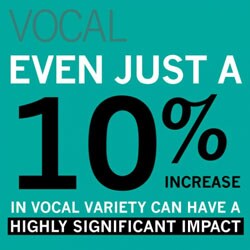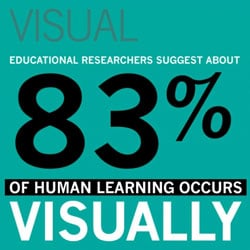A big data approach to public speaking
Key takeaways from analyzing 100,000 presentations


Students in my strategic communication class often ask how they can become more engaging, competent communicators. This question is in no way new — rhetoricians dating back to the ancient Greeks have explored this issue. However, unlike Cicero and Aristotle, we now have big data tools and machine-learning techniques to examine the core characteristics of effective communicators.
One person leveraging this technology (and one of my most popular guest lecturers) is Noah Zandan, founder and CEO of Quantified Communications, which offers one of the first analytics platforms to measure, evaluate, and improve corporate executives’ communication skills.
Zandan’s team of data scientists analyzed more than 100,000 presentations from corporate executives, politicians, and keynote speakers. They examined behaviors ranging from word choices and vocal cues to facial expressions and gesture frequency. They then used this data to rate and rank important communication variables such as persuasiveness, confidence, warmth, and clarity.
Zandan grounds his team’s work in a communication scheme created by psychologist Albert Mehrabian. They expand upon Mehrabian’s original “Three V’s” — the verbal, vocal, and visual choices that a communicator makes — by adding a fourth V: the vital elements of communication.
Here’s what his team has learned through studying the best communicators, combined with concepts I cover in class:
Verbal
The actual words you use, whether spoken or written, matter. Zandan and his team found that the language used in corporate earnings calls affects up to 2.5% of stock price movement. Based on data from the most successful communicators, here are three things to keep in mind. First, word choice should be appropriate for your audience and conform to the context (e.g., formality). Relying on jargon is likely to confuse your audience. The best approach is always to take the time to define terms and technologies that some in your audience might not know. You would also be well-served to have someone review your content specifically to confirm that your word choices are appropriate.
First, word choice should be appropriate for your audience and conform to the context (e.g., formality). Relying on jargon is likely to confuse your audience. The best approach is always to take the time to define terms and technologies that some in your audience might not know. You would also be well-served to have someone review your content specifically to confirm that your word choices are appropriate.
Second, avoid hedging language. Qualifying phrases such as “kind of” and hesitant language like “I think” can be beneficial in interpersonal communication, where they invite contribution and adjust your status relative to the person with whom you are conversing. But in contexts like presenting in public, they can reduce your credibility. You will sound more confident when you remove qualifiers and say “I feel” or “I believe.” The best way to make yourself aware of how often you use hedging language is to have a trusted colleague alert you while giving a practice presentation. Once you’re aware, you will be better able to proactively eliminate this type of language.
Finally, speak clearly and concisely. Research suggests that succinct messages are more memorable. In fact, Zandan and his team found that effective communicators’ messages tend to be more concise than those from speakers who were rated as average or below average. Many presenters speak the way they write — that is, they use complex sentences with nested clauses and phrases. This works well in writing, but when you’re presenting, it’s hard for you to speak and challenging for your audience to follow. In writing, we don’t have to worry about pauses for breath. Nor do we need to worry about the audience understanding what we have written, as a reader can always reread a confusing passage. To be more concise, start by stripping away excess wording that might sound good when read silently but that adds limited value when spoken aloud. When you’re practicing, ask others to paraphrase your points to see if their wording can help you be more succinct.
Vocal
Vocal elements include volume, rate, and cadence. The keys to vocal elements are variation and fluency. Think of your voice like a wind instrument. You can make it louder, softer, faster, or slower. We are wired to pay attention to these kinds of vocal change, which is why it is so hard to listen to a monotonous speaker. In fact, even just a 10% increase in vocal variety can have a highly significant impact on your audience’s attention to and retention of your message. Less expressive speakers should vary their volume and rate by infusing their presentations with emotive words like “excited,” “valuable,” and “challenging,” and using variations in their voice to match the meaning of these words. If you’re speaking about a big opportunity, then say “big” in a big way. With practice, you will feel more comfortable with this type of vocal variety.
Less expressive speakers should vary their volume and rate by infusing their presentations with emotive words like “excited,” “valuable,” and “challenging,” and using variations in their voice to match the meaning of these words. If you’re speaking about a big opportunity, then say “big” in a big way. With practice, you will feel more comfortable with this type of vocal variety.
Disfluencies — all those “ums” and “uhs” — might be the most difficult vocal element to address. Not all disfluencies are distracting. “Ums” and “uhs” within sentences are not perceived as frequently, nor are they as bothersome, as those that occur between thoughts and phrases. Your audience often skips over midsentence disfluencies because they are more focused on your content than your verbal delivery. But as you move from one point to another, disfluencies stand out because your audience is no longer focused on what you are saying. In essence, you are violating your audience’s expectation of a silent pause by filling it.
To address these between-thought disfluencies, be sure to end your sentences, and especially your major points, on an exhalation. By ending your phrases on a complete exhalation, you necessarily start your next thought with an inhalation. It is nearly impossible to say “um” (or anything, for that matter) while inhaling. A useful way to practice this is to read out loud and notice your breathing patterns. In addition to eliminating between-thought disfluencies, your inhalation brings a pause with it. This unfilled pause has the added benefit of varying your rate.
Visual
Visual elements refer to what you do with your body. Zandan cites studies by educational researchers that suggest approximately 83% of human learning occurs visually.Your nonverbal behaviors such as stance, gestures, and eye contact are critical not only for conveying and reinforcing your messages, but they serve as the foundation of your audience’s assessments of your confidence. This is important because your audience equates your competence with their perceptions of your confidence. Your stance is all about being big and balanced. Stand or sit so that your hips and shoulders are square (i.e., not leaning to one side) and keep your head straight, not tilted. Presenting from a balanced position not only helps you appear more confident, but it actually helps you feel more confident, too. When you make yourself big and balanced, you release neurochemicals that blunt anxiety-producing hormones.
Your stance is all about being big and balanced. Stand or sit so that your hips and shoulders are square (i.e., not leaning to one side) and keep your head straight, not tilted. Presenting from a balanced position not only helps you appear more confident, but it actually helps you feel more confident, too. When you make yourself big and balanced, you release neurochemicals that blunt anxiety-producing hormones.
Gestures need to be broad and extended. When you’re gesturing, go beyond your shoulders rather than in front of your chest, which makes you look small and defensive. When you’re not gesturing, place your arms loosely at your sides or clasp your hands loosely right at your belly button level. Finally, remove any distracting items that you might futz or fiddle with, like jewelry, pens, and slide advancers.
Eye contact is all about connecting to your audience. In North American culture, audiences expect eye contact, and quickly feel ostracized when you fail to look out at them. While you need to spread your eye contact around so that you connect with your entire audience, you need not look at each member individually, especially if you are in front of a large crowd. A good strategy is to create quadrants and look in those various directions. Also, try to avoid repetitive patterns when you scan the room. Finally, as Zandan rightly advises his clients, if you are presenting remotely via video camera, imagine you’re speaking directly to people and look into the camera, not at your monitor or keyboard.
Vitals
Vital elements capture a speaker’s true nature — it is what some refer to as authenticity. For authenticity, Zandan’s team has found that the top 10% of authentic speakers were considered to be 1.3 times more trustworthy and 1.3 times more persuasive than the average communicator. Authenticity is made up of the passion and warmth that people have when presenting. Passion comes from exuding energy and enthusiasm. When you’re preparing and practicing your talk, be sure to reflect back on what excites you about your topic and how your audience will benefit. Reminding yourself of your motivation can help energize you (or reenergize you if it’s a presentation you give over and over again). Additionally, thinking about how you are helping your audience learn, grow, and achieve should ignite your spirits. This energy will manifest itself in how you relay your information. This doesn’t mean you have to be a cheerleader you need to find a method for relaying your message that is authentic and meaningful for you.
Passion comes from exuding energy and enthusiasm. When you’re preparing and practicing your talk, be sure to reflect back on what excites you about your topic and how your audience will benefit. Reminding yourself of your motivation can help energize you (or reenergize you if it’s a presentation you give over and over again). Additionally, thinking about how you are helping your audience learn, grow, and achieve should ignite your spirits. This energy will manifest itself in how you relay your information. This doesn’t mean you have to be a cheerleader you need to find a method for relaying your message that is authentic and meaningful for you.
Warmth can be thought of as operationalized empathy. It is a combination of understanding your audience’s needs and displaying that understanding through your words and actions. To be seen as warm, you should acknowledge your audience’s needs by verbally echoing them (e.g., “Like you, I once…”) and by telling stories that convey your understanding of their needs, such as the CEO who tells a story of the most difficult tech support call she had to deal with as she addresses her client services team. Further, maintain an engaged posture by leaning forward and moving toward people who ask questions.
Before your next speech, try out the Four V’s and the specific suggestions derived from big data and machine learning to see if they fit your needs. Only through reflection, practice, and openness to trying new things can you become an engaging, competent communicator.
Matt Abrahams is a Stanford GSB organizational behavior lecturer, author, and communications coach.
First Published: Aug 12, 2016, 07:01
Subscribe Now